Abstract
OBJECTIVE--To quantify the magnitude of the relation between full scale IQ in children aged 5 or more and their body burden of lead. DESIGN--A systematic review of 26 epidemiological studies since 1979: prospective studies of birth cohorts, cross sectional studies of blood lead, and cross sectional studies of tooth lead. SETTING--General populations of children > or = 5 years. MAIN OUTCOME MEASURES--For each study, the regression coefficient of IQ on lead, after adjustment for confounders when possible, was used to derive the estimated change in IQ for a specific doubling of either blood or tooth lead. RESULTS--The five prospective studies with over 1100 children showed no association of cord blood lead or antenatal maternal blood lead with subsequent IQ. Blood lead at around age 2 had a small and significant inverse association with IQ, somewhat greater than that for mean blood lead over the preschool years. The 14 cross sectional studies of blood lead with 3499 children showed a significant inverse association overall, but showed more variation in their results and their ability to allow for confounders. The seven cross sectional studies of tooth lead with 2095 children were more consistent in finding an inverse association, although the estimated magnitude was somewhat smaller. Overall synthesis of this evidence, including a meta-analysis, indicates that a typical doubling of body lead burden (from 10 to 20 micrograms/dl (0.48 to 0.97 mumol/l) blood lead or from 5 to 10 micrograms/g tooth lead) is associated with a mean deficit in full scale IQ of around 1-2 IQ points. CONCLUSION--While low level lead exposure may cause a small IQ deficit, other explanations need considering: are the published studies representative; is there inadequate allowance for confounders; are there selection biases in recruiting and following children; and do children of lower IQ adopt behaviour which makes them more prone to lead uptake (reverse causality)? Even if moderate increases in body lead burden adversely affect IQ, a threshold below which there is negligible influence cannot currently be determined. Because of these uncertainties, the degree of public health priority that should be devoted to detecting and reducing moderate increases in children's blood lead, compared with other important social detriments that impede children's development, needs careful consideration.
Full text
PDF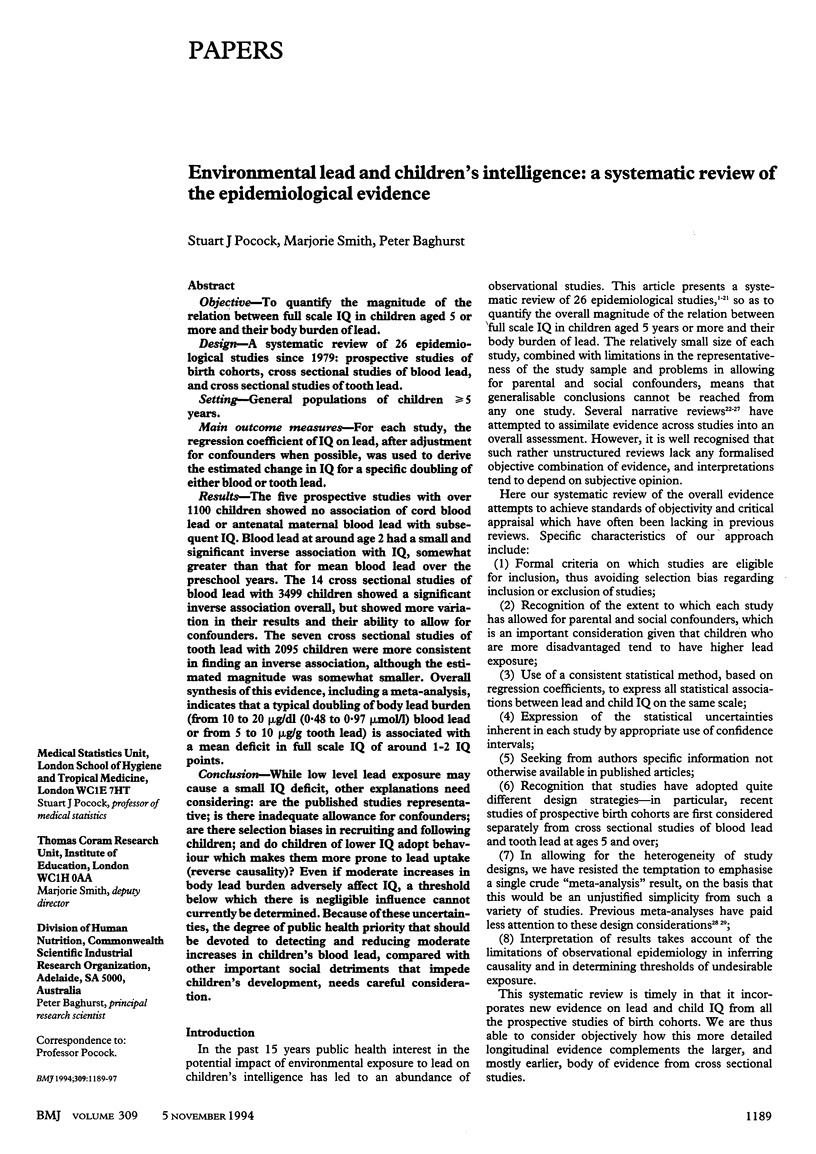

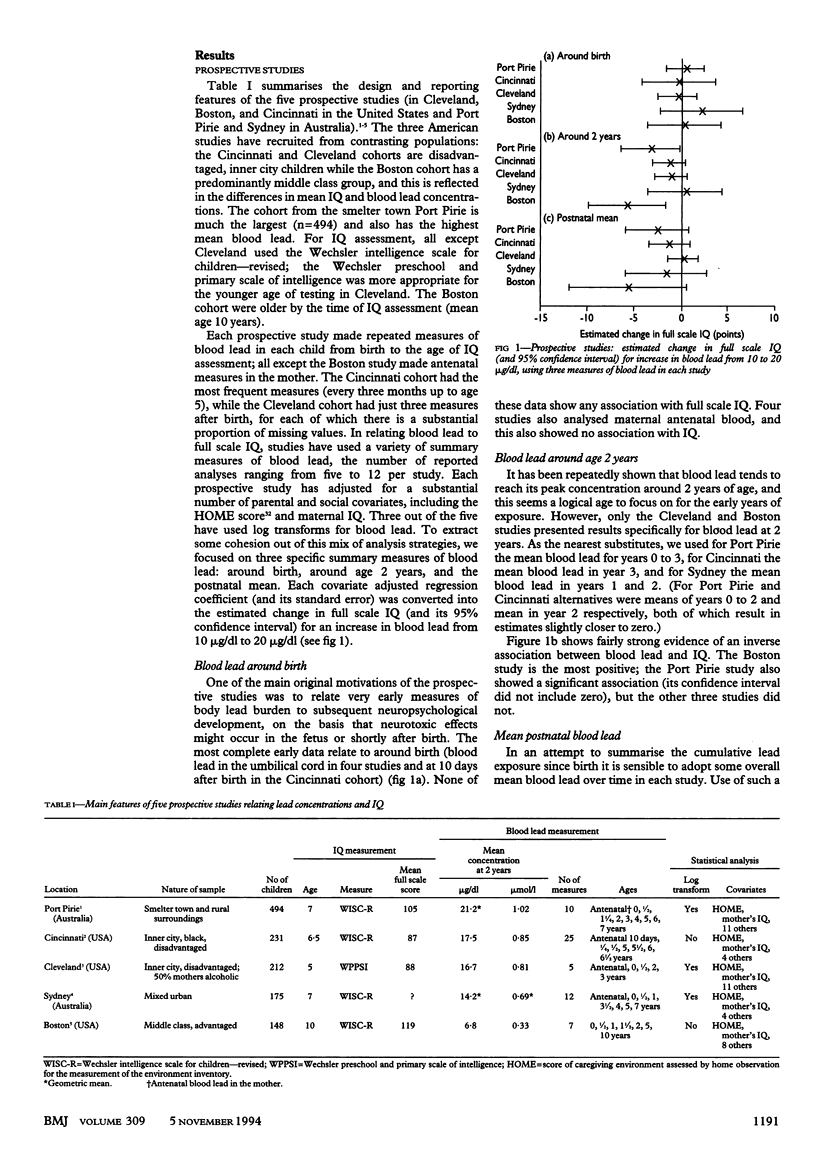
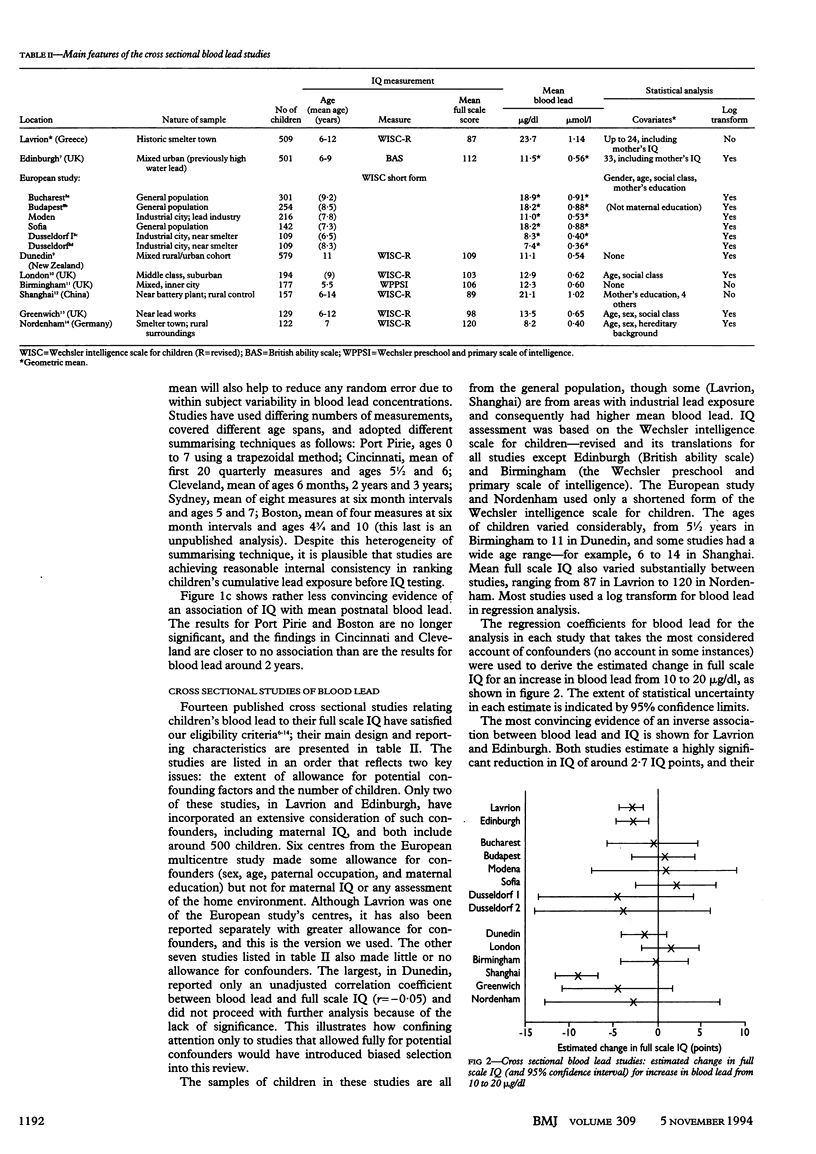
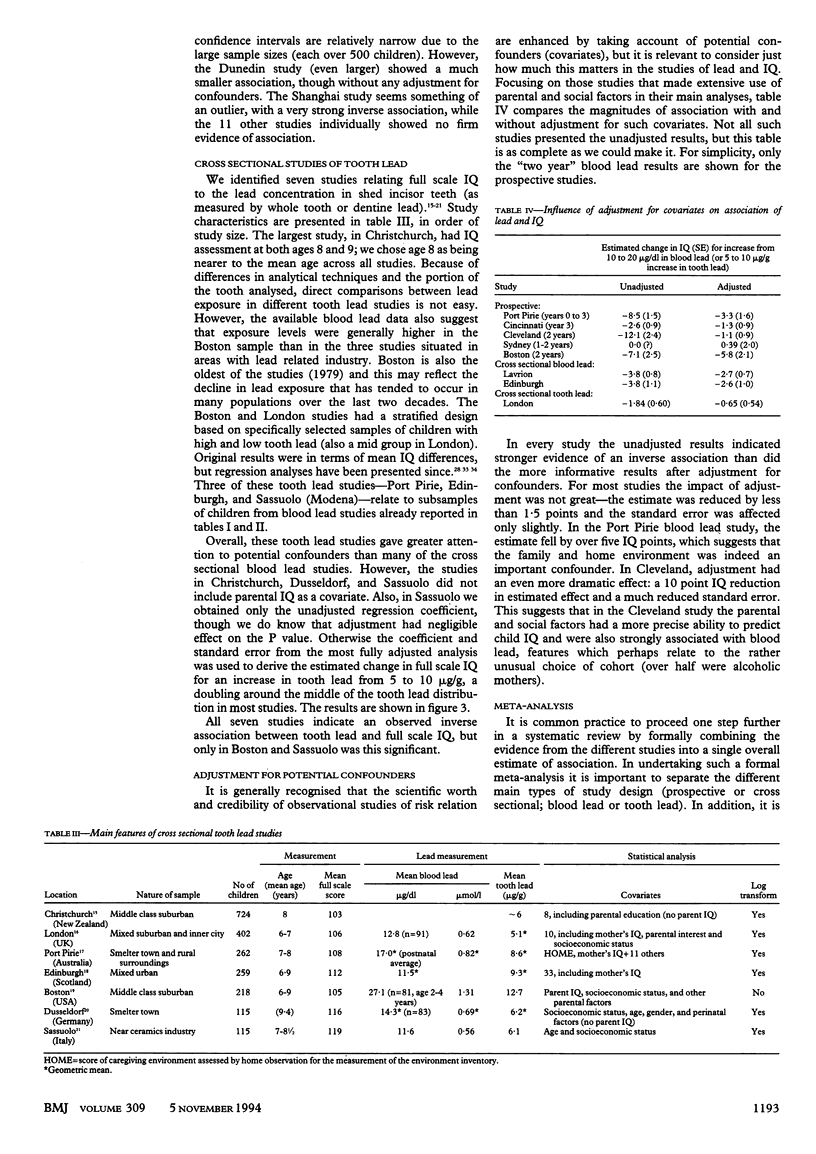

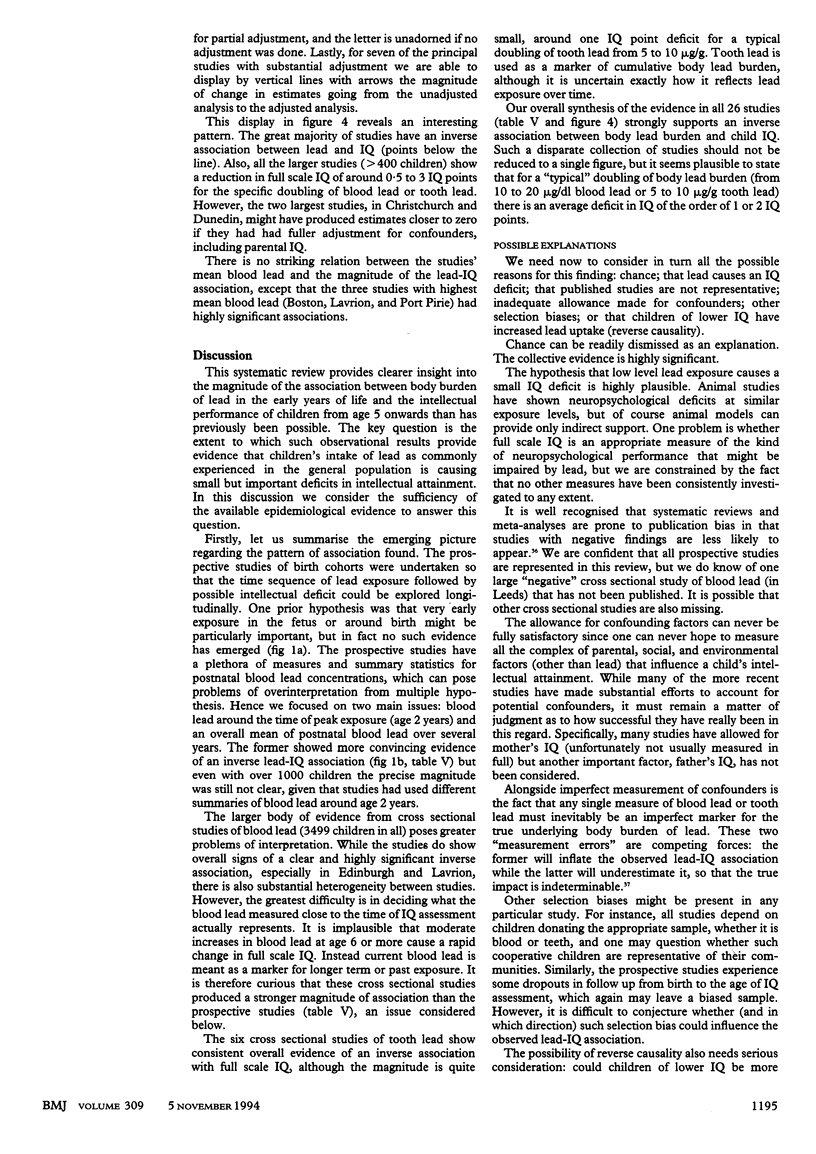
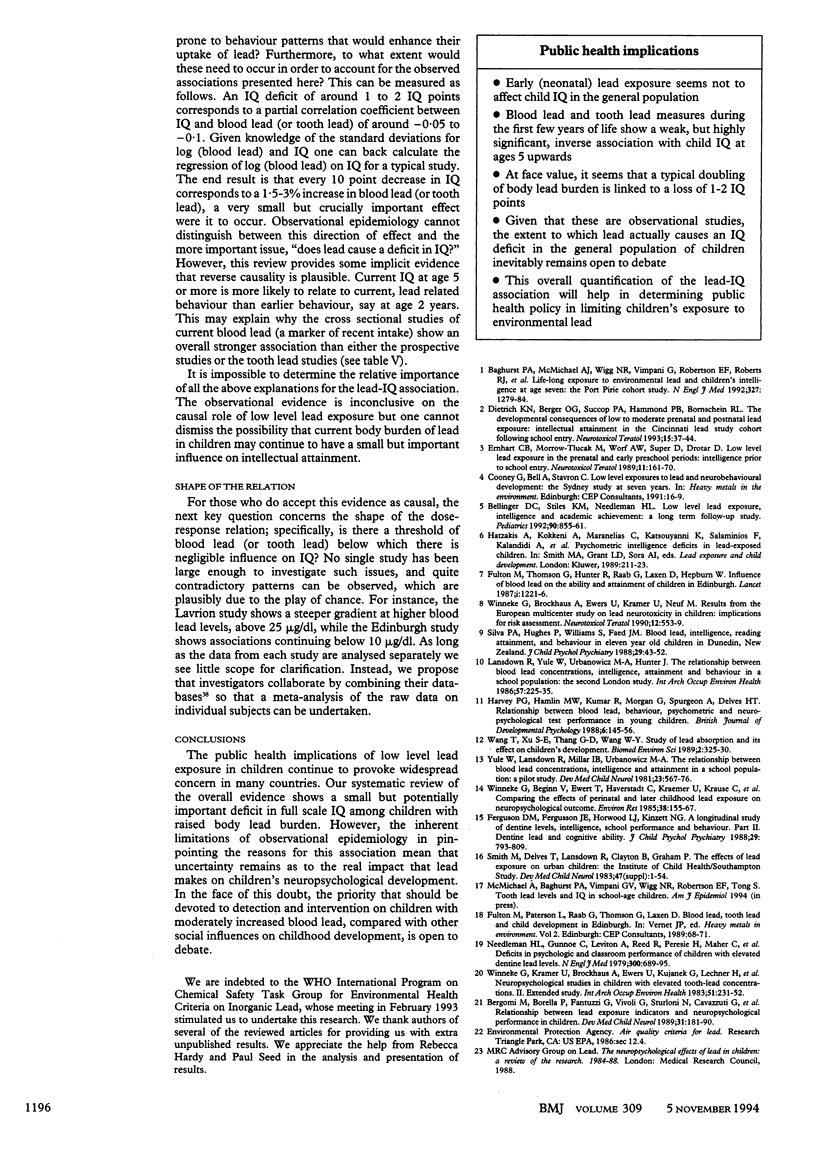
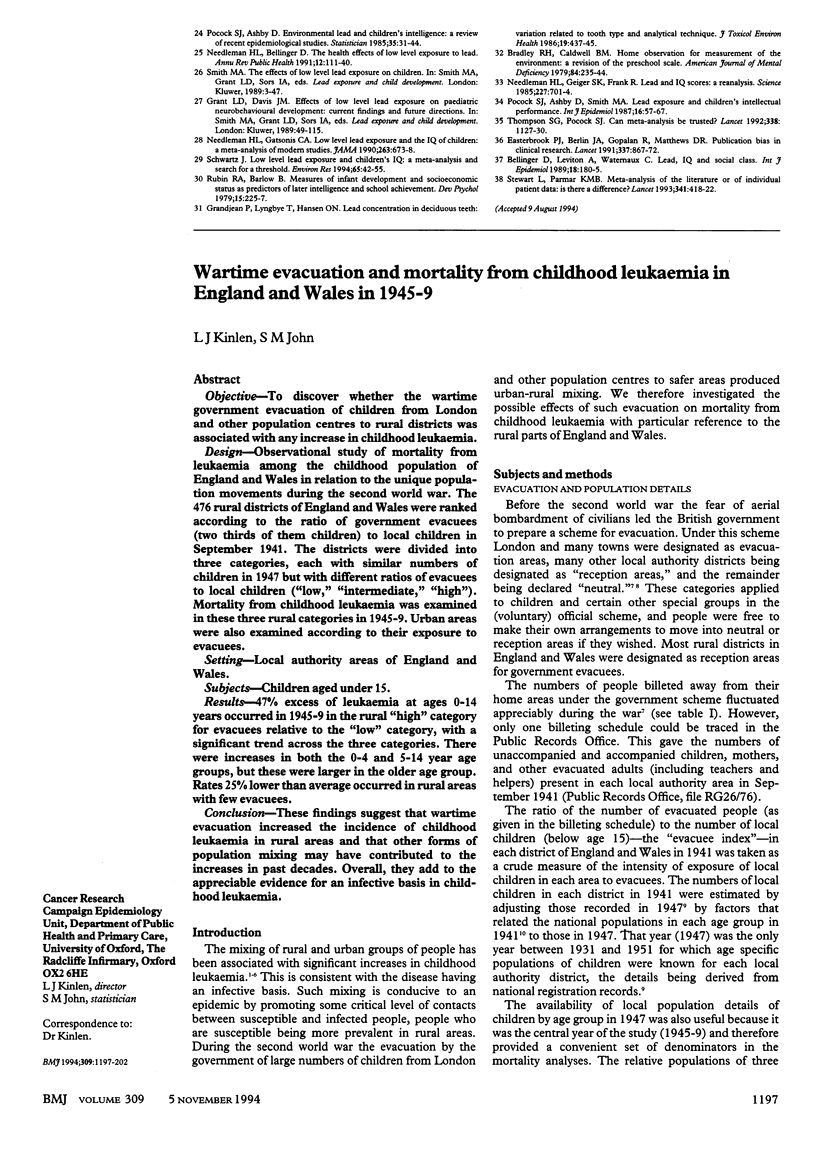
Selected References
These references are in PubMed. This may not be the complete list of references from this article.
- Baghurst P. A., McMichael A. J., Wigg N. R., Vimpani G. V., Robertson E. F., Roberts R. J., Tong S. L. Environmental exposure to lead and children's intelligence at the age of seven years. The Port Pirie Cohort Study. N Engl J Med. 1992 Oct 29;327(18):1279–1284. doi: 10.1056/NEJM199210293271805. [DOI] [PubMed] [Google Scholar]
- Bellinger D. C., Stiles K. M., Needleman H. L. Low-level lead exposure, intelligence and academic achievement: a long-term follow-up study. Pediatrics. 1992 Dec;90(6):855–861. [PubMed] [Google Scholar]
- Bellinger D., Leviton A., Waternaux C. Lead, IQ and social class. Int J Epidemiol. 1989 Mar;18(1):180–185. doi: 10.1093/ije/18.1.180. [DOI] [PubMed] [Google Scholar]
- Bergomi M., Borella P., Fantuzzi G., Vivoli G., Sturloni N., Cavazzuti G., Tampieri A., Tartoni P. L. Relationship between lead exposure indicators and neuropsychological performance in children. Dev Med Child Neurol. 1989 Apr;31(2):181–190. doi: 10.1111/j.1469-8749.1989.tb03977.x. [DOI] [PubMed] [Google Scholar]
- Bradley R. H., Caldwell B. M. Home observation for measurement of the environment: a revision of the preschool scale. Am J Ment Defic. 1979 Nov;84(3):235–244. [PubMed] [Google Scholar]
- Dietrich K. N., Berger O. G., Succop P. A., Hammond P. B., Bornschein R. L. The developmental consequences of low to moderate prenatal and postnatal lead exposure: intellectual attainment in the Cincinnati Lead Study Cohort following school entry. Neurotoxicol Teratol. 1993 Jan-Feb;15(1):37–44. doi: 10.1016/0892-0362(93)90043-n. [DOI] [PubMed] [Google Scholar]
- Easterbrook P. J., Berlin J. A., Gopalan R., Matthews D. R. Publication bias in clinical research. Lancet. 1991 Apr 13;337(8746):867–872. doi: 10.1016/0140-6736(91)90201-y. [DOI] [PubMed] [Google Scholar]
- Ernhart C. B., Morrow-Tlucak M., Wolf A. W., Super D., Drotar D. Low level lead exposure in the prenatal and early preschool periods: intelligence prior to school entry. Neurotoxicol Teratol. 1989 Mar-Apr;11(2):161–170. doi: 10.1016/0892-0362(89)90055-x. [DOI] [PubMed] [Google Scholar]
- Fergusson D. M., Fergusson J. E., Horwood L. J., Kinzett N. G. A longitudinal study of dentine lead levels, intelligence, school performance and behaviour. Part II. Dentine lead and cognitive ability. J Child Psychol Psychiatry. 1988 Nov;29(6):793–809. doi: 10.1111/j.1469-7610.1988.tb00754.x. [DOI] [PubMed] [Google Scholar]
- Fulton M., Raab G., Thomson G., Laxen D., Hunter R., Hepburn W. Influence of blood lead on the ability and attainment of children in Edinburgh. Lancet. 1987 May 30;1(8544):1221–1226. doi: 10.1016/s0140-6736(87)92683-3. [DOI] [PubMed] [Google Scholar]
- Grandjean P., Lyngbye T., Hansen O. N. Lead concentration in deciduous teeth: variation related to tooth type and analytical technique. J Toxicol Environ Health. 1986;19(3):437–444. doi: 10.1080/15287398609530941. [DOI] [PubMed] [Google Scholar]
- Lansdown R., Yule W., Urbanowicz M. A., Hunter J. The relationship between blood-lead concentrations, intelligence, attainment and behaviour in a school population: the second London study. Int Arch Occup Environ Health. 1986;57(3):225–235. doi: 10.1007/BF00405790. [DOI] [PubMed] [Google Scholar]
- Needleman H. L., Bellinger D. The health effects of low level exposure to lead. Annu Rev Public Health. 1991;12:111–140. doi: 10.1146/annurev.pu.12.050191.000551. [DOI] [PubMed] [Google Scholar]
- Needleman H. L., Gatsonis C. A. Low-level lead exposure and the IQ of children. A meta-analysis of modern studies. JAMA. 1990 Feb 2;263(5):673–678. [PubMed] [Google Scholar]
- Needleman H. L., Geiger S. K., Frank R. Lead and IQ scores: a reanalysis. Science. 1985 Feb 15;227(4688):701-2, 704. [PubMed] [Google Scholar]
- Needleman H. L., Gunnoe C., Leviton A., Reed R., Peresie H., Maher C., Barrett P. Deficits in psychologic and classroom performance of children with elevated dentine lead levels. N Engl J Med. 1979 Mar 29;300(13):689–695. doi: 10.1056/NEJM197903293001301. [DOI] [PubMed] [Google Scholar]
- Pocock S. J., Ashby D., Smith M. A. Lead exposure and children's intellectual performance. Int J Epidemiol. 1987 Mar;16(1):57–67. doi: 10.1093/ije/16.1.57. [DOI] [PubMed] [Google Scholar]
- Schwartz J. Low-level lead exposure and children's IQ: a meta-analysis and search for a threshold. Environ Res. 1994 Apr;65(1):42–55. doi: 10.1006/enrs.1994.1020. [DOI] [PubMed] [Google Scholar]
- Silva P. A., Hughes P., Williams S., Faed J. M. Blood lead, intelligence, reading attainment, and behaviour in eleven year old children in Dunedin, New Zealand. J Child Psychol Psychiatry. 1988 Jan;29(1):43–52. doi: 10.1111/j.1469-7610.1988.tb00687.x. [DOI] [PubMed] [Google Scholar]
- Smith M., Delves T., Lansdown R., Clayton B., Graham P. The effects of lead exposure on urban children: the Institute of Child Health/Southampton Study. Dev Med Child Neurol Suppl. 1983;47:1–54. [PubMed] [Google Scholar]
- Stewart L. A., Parmar M. K. Meta-analysis of the literature or of individual patient data: is there a difference? Lancet. 1993 Feb 13;341(8842):418–422. doi: 10.1016/0140-6736(93)93004-k. [DOI] [PubMed] [Google Scholar]
- Thompson S. G., Pocock S. J. Can meta-analyses be trusted? Lancet. 1991 Nov 2;338(8775):1127–1130. doi: 10.1016/0140-6736(91)91975-z. [DOI] [PubMed] [Google Scholar]
- Wang L., Xu S. E., Zhang G. D., Wang W. Y. Study of lead absorption and its effect on children's development. Biomed Environ Sci. 1989 Dec;2(4):325–330. [PubMed] [Google Scholar]
- Winneke G., Beginn U., Ewert T., Havestadt C., Kraemer U., Krause C., Thron H. L., Wagner H. M. Comparing the effects of perinatal and later childhood lead exposure on neuropsychological outcome. Environ Res. 1985 Oct;38(1):155–167. doi: 10.1016/0013-9351(85)90081-7. [DOI] [PubMed] [Google Scholar]
- Winneke G., Brockhaus A., Ewers U., Krämer U., Neuf M. Results from the European multicenter study on lead neurotoxicity in children: implications for risk assessment. Neurotoxicol Teratol. 1990 Sep-Oct;12(5):553–559. doi: 10.1016/0892-0362(90)90022-5. [DOI] [PubMed] [Google Scholar]
- Winneke G., Krämer U., Brockhaus A., Ewers U., Kujanek G., Lechner H., Janke W. Neuropsychological studies in children with elevated tooth-lead concentrations. II. Extended study. Int Arch Occup Environ Health. 1983;51(3):231–252. doi: 10.1007/BF00377755. [DOI] [PubMed] [Google Scholar]
- Yule Q., Lansdown R., Millar I. B., Urbanowicz M. A. The relationship between blood lead concentrations, intelligence and attainment in a school population: a pilot study. Dev Med Child Neurol. 1981 Oct;23(5):567–576. doi: 10.1111/j.1469-8749.1981.tb02038.x. [DOI] [PubMed] [Google Scholar]


